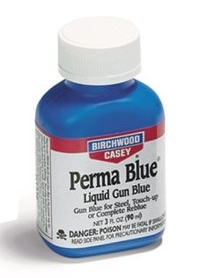A black oxide coating is the official term for turning steel parts black. This rust resistant coating looks good and is an important step to ensuring that fan you worked so many hours on is looked upon by others just as fondly as yourself.
Also known as "bluing," black oxide coating is a chemical process by which the iron in the steel is turned into magnetite, creating a deep black coloration. This can be accomplished through a few different means including "hot bluing" or "cold bluing." Technically cold bluing is not truly a black-oxide coating because it does not produce the same magnetite finish as would be found when hot bluing, but it is much simpler and looks just as good; although it will not be as corrosion resistant or durable.
Hot bluing is quite an elaborate and dangerous process and I will detail it in a future article. Fortunately cold bluing is a simple process and can be done easily at home. In this article I'll disclose my steps to using a common cold-bluing chemical (Birchwood Casey's Gun Blue) and obtaining excellent results with it.
Step 1: Degrease the Components
I typically degrease using mineral spirits in an ultrasonic bath at 120deg F for 30minutes.
Step 2: Acid Etch the Components
Using muriatic acid (purchased from Home Depot or Lowes) diluted 1:1 with water, allow the parts to etch for about 15minutes. Muriatic acid is EXTREMELY lethal. Do NOT use this chemical unless you know exactly what you are doing and be sure to wear gloves, a respirator and work within a well ventilated environment.
Step 3: Soak in Birchwood Gun Blue
After etching, rinse in fresh water to remove the acid. Next let the parts soak in the gun blue solution, ensuring that they are completely covered. I let them soak for 15minutes. When the parts are finished soaking you can return the solution back to its container.
Step 4: Soak the Finished Parts in Oil
After removing the parts from the bluing solution, rinse them in water briefly, dry them off gently and soak them in oil. It doesn't really matter which oil you use; any oil will be fine. The oil soaks into the black-oxide surface and protects it from rust. In reality, the oil is actually the true rust preventative with cold-bluing so be sure that the parts are always well oiled. You can also use wax but the parts will have a dull look instead of gloss.





